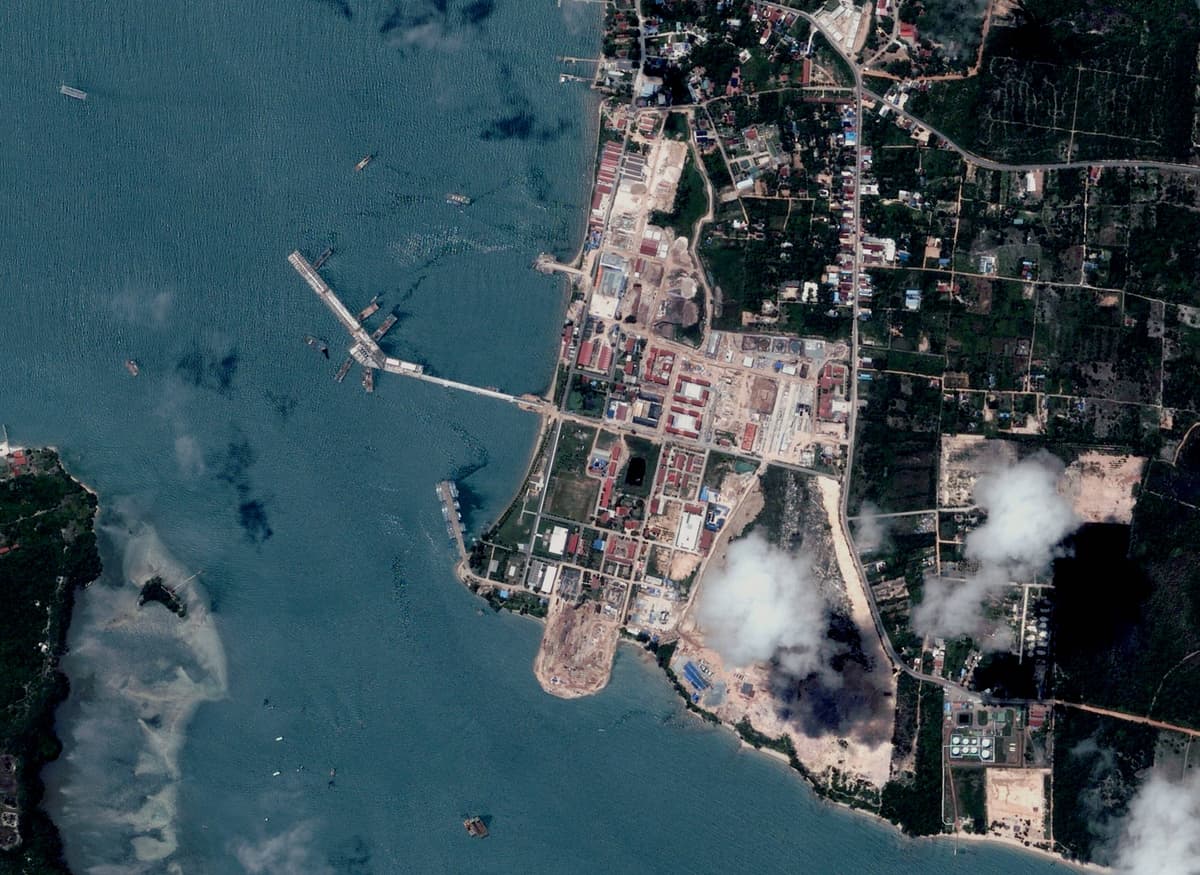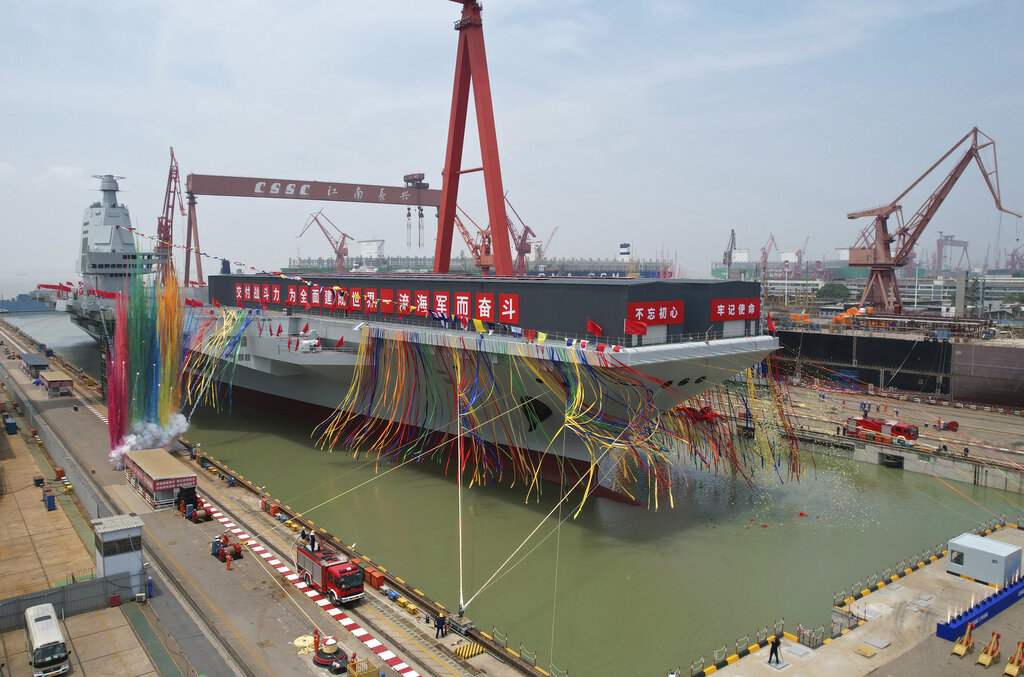Exclusive: China Completing Major Naval Base in Cambodia, Capable of Docking Its New Generation of Carriers
Strategic gain is seen for the Communist giant, as Cambodia emerges as its proxy in Southeast Asia.

KAMPOT, Cambodia — Communist China, in a big step of force projection for its new blue water navy, is completing on Cambodia’s coast a pier capable of berthing one of China’s three new aircraft carriers.
The pier has the same length — 1,100 feet — and the same elbow design as a carrier capable pier built on China’s only existing overseas naval base, in Djibouti, on the Horn of Africa.
Analysts originally thought the pier at Cambodia’s Ream Naval Base was a temporary structure built to land construction materials. In recent months, though, the pier was lengthened and hardened, according to a series of satellite photos released by BlackSky Technology Inc., a Virginia-based commercial satellite imagery company.
“There is a near-exact similarity between an angled deep-water pier located on the western shore of the Ream base and another military pier at the People’s Liberation Army Support Base in Djibouti,” says the China Program Director, Craig Singleton, at the Foundation for Defense of Democracies at Washington. “Both main piers are 363 meters long and large enough to support any ship in China’s naval arsenal, including the new 300-meter-long Type 003 Fujian aircraft carrier.”

At the same time, clamshell dredgers owned by China Metallurgical Group Corporation, are deepening sea access to the Cambodian pier, according to the Washington-based Asia Maritime Transparency Initiative.
On shore, Chinese workers are building 35 buildings on a northern section of the Cambodian base. They dress in civilian clothes or in Cambodian-style military uniforms in order to avoid stirring up anti-Chinese sentiment among Cambodians.
In the past year, visits by American officials have been tightly circumscribed at Ream, 50 miles west of here. Chinese workers have demolished two American-funded Cambodian Navy buildings and moved off base to a Vietnamese “Joint Vietnamese Friendship” building.
Vietnam is a historical rival — and sometimes enemy — of China. Only 15 miles to the east of Ream lies Vietnam’s largest island, Phu Quoc. The Vietnamese Navy’s Fifth Regional Command is based on Phu Quoc.
Just the way Djibouti controls a 10-mile wide choke point for vessels passing through the Suez Canal, Ream is only 650 miles north of the Strait of Malacca, the point where the Indian Ocean meets the Pacific Ocean. About one quarter of all seaborne oil shipments pass through this strait.
China’s economy depends on seaborne trade. Its People’s Liberation Army Navy, or PLAN, has more surface ships and submarines — 350 — than the US Navy – 293. China, though, lacks the kind of globe-straddling support bases and treaty agreements that America has.
With the inauguration here of the pier expected in coming weeks, Cambodian and Chinese officials insist that China is investing only to bolster Cambodia’s Navy. Cambodia’s constitution bars foreign military bases on Cambodian territory.
Yet in 2019, when the project was gestating, the Wall Street Journal reported that a secret agreement allows China to use about one third of the 192-acre base for 30 years. The agreement allows China’s military personnel to carry weapons and Cambodian passports and requires Cambodians to get Chinese permission to enter the Chinese section of the base, American officials told the Journal.
Last year, in separate visits to Phnom Penh, Secretary of State Blinken and then President Biden complained of Chinese military construction at Ream, which is on the Gulf of Thailand. In November, Mr. Biden met with Cambodia’s prime minister, Hun Sen, and “raised concerns regarding the situation at Ream Naval Base and underscored the importance of full transparency about activities by the PRC military at Ream Naval Base,” according to the White House.
Ream is part of wider Chinese involvement in Cambodia, a small nation of 17 million people, sandwiched between Vietnam and Thailand. China is Cambodia’s largest trading partner, largest investor, largest arms supplier, and largest creditor — holder of about half of Cambodia’s $10 billion foreign debt. Addressing a flood of tourists, gamblers, and investors, street advertisements here increasingly are bilingual — in Cambodian and Chinese.
While the big pier and the onshore logistical facilities seemed to be designed for China’s Navy, another huge investment 40 miles up Cambodia’s coast may be designed for China’s Air Force. At Dara Sakor, a private Chinese company, Union Development Group, has carved out of the jungle Cambodia’s longest airstrip.
Although the Chinese company has a 99-year lease on 20 percent of Cambodia’s coastline, tourism development lags. Now, Koh Kong, a province with only 125,000 persons, has a two-mile long cement strip capable of handling Boeing 747s and Airbus A380s, not to mention China’s long-range bombers. Warplanes flying from Dara Sakor would be able to strike targets in Thailand, Vietnam, and Singapore.
China’s largesse comes with a price tag, analysts say. For a decade, Cambodia has been seen as “China’s proxy” inside the 10-member Association of Southeast Asian Nations, or ASEAN. Time and again, Cambodia has blocked moves to strengthen the regional group in face of Chinese maritime claims.
Last month, Cambodia torpedoed an Indonesian proposal to hold ASEAN naval drills in waters contested by China and Indonesia. Cambodia’s determination to defend China inside ASEAN has been so strong that Singapore has discussed kicking Cambodia out of the regional bloc.
In recent years, due to Hun Sen’s destruction of democracy, America suspended joint military projects with Cambodia and then suspended arms deliveries. China has stepped into the breach. In March, Cambodia and China held Operation Golden Dragon — joint military exercises on land.
That same month, in waters near Ream, the two countries held their first-ever naval drills. The defense minister, General Tea Banh, said the Chinese military provided ammunition, explosives, gasoline, and military equipment. After drills ended on land, the Chinese military handed to Cambodia all military equipment.

